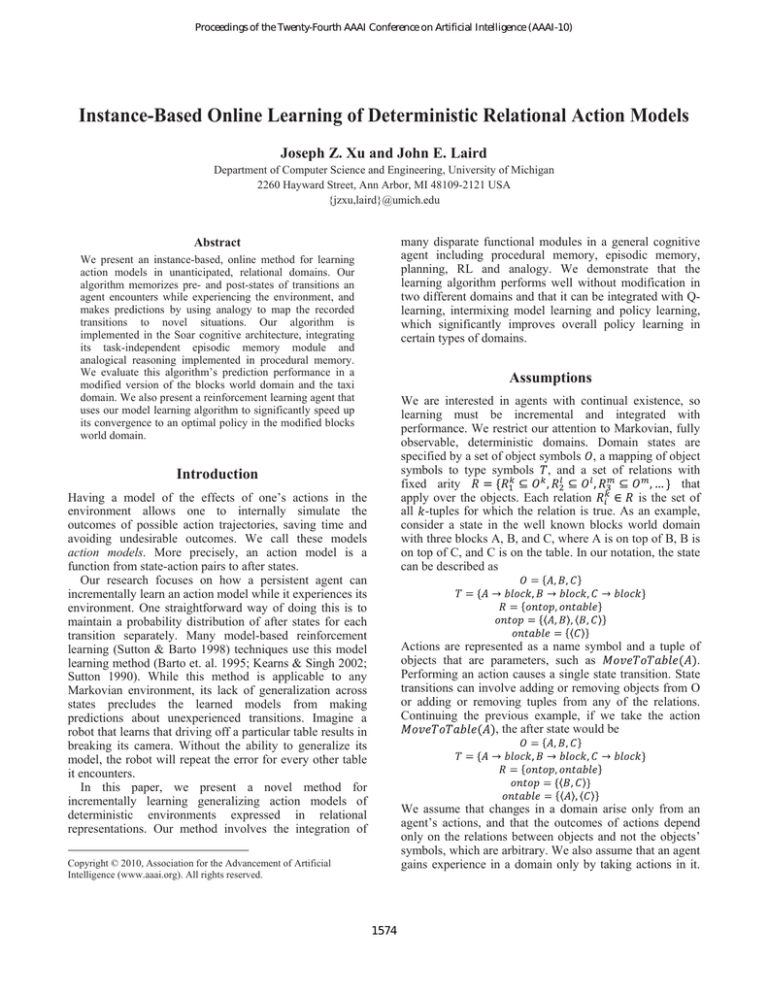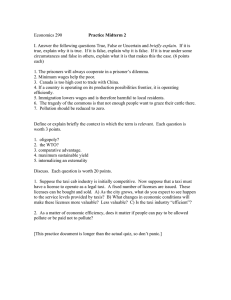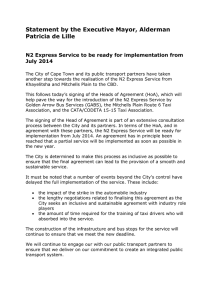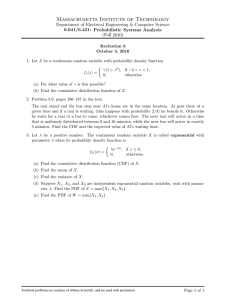
Proceedings of the Twenty-Fourth AAAI Conference on Artificial Intelligence (AAAI-10)
Instance-Based Online Learning of Deterministic Relational Action Models
Joseph Z. Xu and John E. Laird
Department of Computer Science and Engineering, University of Michigan
2260 Hayward Street, Ann Arbor, MI 48109-2121 USA
{jzxu,laird}@umich.edu
many disparate functional modules in a general cognitive
agent including procedural memory, episodic memory,
planning, RL and analogy. We demonstrate that the
learning algorithm performs well without modification in
two different domains and that it can be integrated with Qlearning, intermixing model learning and policy learning,
which significantly improves overall policy learning in
certain types of domains.
Abstract
We present an instance-based, online method for learning
action models in unanticipated, relational domains. Our
algorithm memorizes pre- and post-states of transitions an
agent encounters while experiencing the environment, and
makes predictions by using analogy to map the recorded
transitions to novel situations. Our algorithm is
implemented in the Soar cognitive architecture, integrating
its task-independent episodic memory module and
analogical reasoning implemented in procedural memory.
We evaluate this algorithm’s prediction performance in a
modified version of the blocks world domain and the taxi
domain. We also present a reinforcement learning agent that
uses our model learning algorithm to significantly speed up
its convergence to an optimal policy in the modified blocks
world domain.
Assumptions
We are interested in agents with continual existence, so
learning must be incremental and integrated with
performance. We restrict our attention to Markovian, fully
observable, deterministic domains. Domain states are
specified by a set of object symbols , a mapping of object
symbols to type symbols , and a set of relations with
that
fixed arity
is the set of
apply over the objects. Each relation
all -tuples for which the relation is true. As an example,
consider a state in the well known blocks world domain
with three blocks A, B, and C, where A is on top of B, B is
on top of C, and C is on the table. In our notation, the state
can be described as
Introduction
Having a model of the effects of one’s actions in the
environment allows one to internally simulate the
outcomes of possible action trajectories, saving time and
avoiding undesirable outcomes. We call these models
action models. More precisely, an action model is a
function from state-action pairs to after states.
Our research focuses on how a persistent agent can
incrementally learn an action model while it experiences its
environment. One straightforward way of doing this is to
maintain a probability distribution of after states for each
transition separately. Many model-based reinforcement
learning (Sutton & Barto 1998) techniques use this model
learning method (Barto et. al. 1995; Kearns & Singh 2002;
Sutton 1990). While this method is applicable to any
Markovian environment, its lack of generalization across
states precludes the learned models from making
predictions about unexperienced transitions. Imagine a
robot that learns that driving off a particular table results in
breaking its camera. Without the ability to generalize its
model, the robot will repeat the error for every other table
it encounters.
In this paper, we present a novel method for
incrementally learning generalizing action models of
deterministic environments expressed in relational
representations. Our method involves the integration of
Actions are represented as a name symbol and a tuple of
.
objects that are parameters, such as
Performing an action causes a single state transition. State
transitions can involve adding or removing objects from O
or adding or removing tuples from any of the relations.
Continuing the previous example, if we take the action
, the after state would be
We assume that changes in a domain arise only from an
agent’s actions, and that the outcomes of actions depend
only on the relations between objects and not the objects’
symbols, which are arbitrary. We also assume that an agent
gains experience in a domain only by taking actions in it.
Copyright © 2010, Association for the Advancement of Artificial
Intelligence (www.aaai.org). All rights reserved.
1574
Thus, the training instances for learning action models are
local to the agent’s trajectory through the environment,
rather than being a uniform random sampling of all
possible transitions. Therefore, the model learning
algorithm must cope with biased training examples, and
must modify the model as new examples are collected.
Finally, we assume that an agent knows which actions are
valid to execute in every state, but cannot directly reason
about the action preconditions.
Figure 1. Working memory encoding of blocks world state
between all mechanisms occurs via Soar’s shared working
memory, which represents data as a labeled graph. Soar
has an episodic memory module (Derbinsky 2009; Nuxoll
2007) that effectively takes snapshots of its working
memory state, called episodes, at regular intervals and
stores them in chronological order. An episode can be
retrieved by matching its contents to a cue or by next and
previous temporal relationships. In cue based retrieval, a
working memory graph is provided as a cue, and the
episode with the highest degree of structural match to the
cue is retrieved. The degree of structural match is
calculated as the number of vertices shared by the episode
and cue that have identical contexts. An episode that has a
subgraph isomorphism to the cue represents the best
possible match. Ties are broken by episode recency.
Derbinsky & Laird (2009) present evidence that cue-based
retrieval is tractable even with one million stored episodes.
Soar also has a reinforcement learning module that tunes
agent behavior with Q-learning (Nason & Laird 2004).
Soar’s episodic memory provides the basis for learning
an action model by automatically storing all state
transitions experienced by the agent. However, to support
predictions in novel situations, the agent must also be able
to generalize stored transitions with analogy. We encode
the relational representation of the task in working
memory, as shown in Figure 1. To make a prediction for
in state , the agent first retrieves a
taking action
that is similar to , in
previously encountered state
which it also performed , and the following state . It
changed
then compares those states to determine how
due to it taking action . is analogically mapped onto
to obtain a feature correspondence, which is then used to
onto to obtain the
map the changes calculated for
prediction. These four major steps: retrieval, finding
changes, feature mapping, and mapping changes, make up
the subsections below. Figure 2 shows an example in
blocks world where the agent must predict what happens
when block B is moved from block A to C. We will ground
the description of each step in this example.
To simplify the algorithm description, we introduce
the target state,
the target
some terminology. Call
the source state, and
the after state. Let
,
action,
, and
be the set of objects in the source, target, and
, and
the set of relations in the
after states, and ,
source, target, and after states, respectively. Let
be a mapping of objects from source to target state, and
be a mapping of the elements of the
relation from source to target state.
Related Work
There are several existing pieces of work on learning
action models, none of which covers all the criteria
discussed above: being online, incremental, relational, and
generalizing. Wang’s system (Wang 1995) learns STRIPS
operators from observing multiple expert planning traces,
creating the most general operators that cover all traces.
This method requires representative training instances and
access to a simulator for the domain, violating our
assumption that the agent has no information about its
environment beyond its own experiences.
TRAIL (Benson 1995) has a learning component that
uses inductive logic programming (ILP) to learn
preconditions for actions. Although training examples are
obtained online from plan execution, the algorithm is not
incremental in that it must wait for a sufficient number of
positive and negative instances before attempting ILP. It is
unclear from the paper how this number is determined and
how the system deals with unrepresentative training data
inherent to online sampling.
Pasula et. al. (2007) developed an algorithm that
generates a set of relational rules from training examples
that describe the distribution of outcomes of probabilistic
actions. It does this by searching the space of possible rules
for a set that balances training data consistency with
complexity. This approach also requires the training data to
be a representative sampling of the entire space of
transitions because it cannot dynamically incorporate new
training instances, which violates our requirement that the
agent collect experiences online.
Diuk et al. (2008) introduce a formalism called
Deterministic Object-Oriented MDPs and an algorithm for
learning deterministic action models within this formalism.
The algorithm starts with specific rules based on single
transition observations and moves to more general rules as
more transitions are experienced and observed effects are
combined. The algorithm is incremental and online, but it
does not use relational representations, so it unable to
generalize across object instances.
Algorithm Description
Our algorithm is implemented in Soar (Laird 2008), a
cognitive architecture that incorporates the necessary
learning, memory, and control mechanisms to create agents
with the capabilities described above. Communication
Retrieval. The first step of the algorithm retrieves the
1575
performing simple set comparisons between the two states.
The algorithm computes the added and removed objects,
and the added and removed relation tuples:
In the example, the on relation between A and C is
removed while a new on relation between A and B is
added. Also, C is now clear whereas B is no longer clear.
Feature Mapping. Next, the system determines the
correspondence between the objects and relation tuples in
the source state and those in the target state. Our algorithm
attempts to map state features to maximize the structural
correspondence between the source and target states. It is
inspired by the Structure Mapping theory and its
implementation, the Structure Mapping Engine
(Falkenheiner et. al. 1989). Our mapping algorithm is
simpler than SME, and we are only concerned with withindomain mappings whereas they are also concerned with
cross-domain mappings.
The mapping algorithm is iterative and maintains a set
of candidate source-target relation tuple mappings at each
and a target relation
step. A source relation tuple
make up a candidate mapping
to be
tuple
if at least one of their corresponding
included into
parameters have already been mapped to each other:
The mapping algorithm starts with the parameters of the
source actions mapped to those in the target action. At each
step, it chooses one candidate relation mapping to be
. There are usually many choices, and
included into
instead of performing a combinatorial search over the
different possible orderings of commitments, we use
simple heuristics to assign preferences to them. For
example, the algorithm prefers to map relation tuples that
have more parameters already mapped. Ties are broken
randomly. Once it commits to a tuple mapping, all of their
unmapped parameters are also mapped to each other:
Figure 2. Example prediction algorithm run
transition that is most analogous to the one being predicted
from episodic memory. This is done by performing a cuebased retrieval using only the relation tuples from the
target state and action that are relevant in determining the
outcome of the action. Object identities are ignored
because we assume actions are conditioned only on
relations. This alone achieves some generalization that
would not be possible without a relational representation.
The agent does not know a priori which relation tuples
are relevant to predicting the outcome of a specific action.
We use a proximity heuristic that chooses tuples within a
chosen order of syntactic connectivity to the action
parameters. First order tuples are those involving action
parameters, second order those that share parameters with
first order tuples, etc. We use this heuristic because
causality is usually local to the objects being acted upon,
and syntactic connectivity reflects this locality. In the
example, the cue consists of first order tuples with B and C
as parameters, while ontable(A) is a second order tuple and
thus is not included.
After the cue based retrieval returns the source state, the
agent performs a next retrieval to obtain the after state. In
the example, the agent retrieves a source state in which it
moved A from C to B. It then retrieves the state after the
action occurred, with A stacked on B.
The new object mappings in turn introduce more candidate
tuple maps in the next iteration. This process continues
until there are no more mapping candidates.
The algorithm also needs to map objects and relation
tuples added in the after state to their analogues in the
prediction. Each new object in the after state is mapped to
a unique new object symbol.
Each new relation tuple
relation tuple where
in the after state is mapped to a
In the example, A is first mapped to B and B to C since
they are the action parameters. The clear and ontable
relations for those objects are then mapped, followed by
the on relations. The other parameters of the on relations, C
and A, are then mapped, which then allows ontable(C) to
be mapped to ontable(A). Lastly, the new relation tuples,
indicated by gray text, are mapped.
Finding Changes. After retrieving the source and after
states, the system determines what changes occurred by
1576
Mapping Changes. Finally, the changes calculated for the
source transition are mapped onto the target state using the
mappings from the previous step to obtain the prediction.
Experiment 1: Prediction Performance
Our first experiment tests the prediction performance of
our algorithm by measuring the number of correct
predictions it makes with respect to the size of its episodic
memory. We do this by first recording a random trajectory
through an environment, then measuring the number of
transitions in that trajectory our action model correctly
predicts given increasing length prefixes of the trajectory
as its episodic store. This measures the contribution that
additional episodes make to accuracy. We test prefix
lengths at powers of 2 to show the increase in accuracy per
doubling of experience.
This testing methodology is different from the
traditional methodology for testing learning algorithms in
which the training set and test set are independently
generated. Our “training set” (episodic store) and test set
come from the same trajectory. This is because unlike
traditional learning algorithms that freeze their model after
the designated training period, the training of our algorithm
occurs online, simultaneously with performance, and test
instances eventually become training instances.
In the example, mapping changes from the source state
results in the prediction that B will be on C.
Finally, it is worth noting that cue-based retrieval returns
the best match to the cue, which may not be an exact
match. When making a prediction for an unexperienced
transition, the algorithm retrieves the memorized transition
that is structurally most similar to it, and then through
analogical mapping attempts to adapt the outcome of the
memorized transition to the novel one. This is how the
model generalizes to novel situations.
Our approach makes predictions directly from stored
transitions and is thus an instance-based learning (IBL)
algorithm (Aha et al. 1991). As with IBL methods, it is
incremental, anytime, and suitable for online training.
Experiments and Results
Breaking Blocks World. Figure 3 shows the prediction
accuracy averaged over 30 trials for two different feature
connectivity orders used in the cue. The straight line shows
the expected success rate if no generalization occurred and
only seen transitions are correctly predicted.
The predictor generalizes over very few episodes to
successfully predict many transitions. With just a single
transition in memory, it can predict about a third of all
transitions in the trajectory correctly. This is not surprising,
considering that the MoveToBlock action is highly
prototypical even in this modified version of blocks world.
However, taking advantage of this regularity without
explicit knowledge of the domain speaks for the strength of
analogical mapping. With 32 episodes recorded, the model
predicts about 88% of the transitions correctly. But even
when episodic memory contains all the test episodes, the
model still makes prediction errors. This is because the
connectivity heuristic does not always include all the state
features relevant to the action being predicted in the
retrieval cue. This leads to the retrieval of more recent
episodes that match the cue perfectly, even though the
states are not the same in all relevant respects.
The figure also shows that using a low connectivity
order in the cue gives better performance with fewer
episodes stored in memory, but worse performance with
more episodes. This is because low connectivity order
encourages more generalization, but also discourages
We evaluate this approach on two domains – the first
designed specifically to stress action modeling, and the
second used in previous RL research.
Breaking Blocks World
This domain is identical to ordinary blocks world except
that the robot gripper can pick up any block, not just the
blocks at the tops of stacks. If it tries to pick up a block
from the middle of a stack, all blocks stacked above that
block fall to the ground and break. Breaking blocks results
in a large negative reward. The task ends when all
unbroken blocks are stacked in a single column in order.
This domain also has an extra relation, above, the transitive
version of the on relation. This helps the agent determine
the relevant context of move actions, but makes predicting
the result of moves more difficult.
Breaking blocks world presents a significant challenge
for action modeling. Predicting which blocks will break
requires taking into account which blocks are above the
one being moved. Predicting new above tuples requires
taking into account the blocks below the destination.
Taxi Domain
In the Taxi domain (Dietterich 1998), the agent controls a
taxi that navigates in a grid-based map with walls that the
taxi cannot pass through. The goal is to pick up and deliver
a passenger to a given destination. The taxi can move in
the four cardinal directions, pick up the passenger when the
taxi is in the same cell, drop off the passenger, and refill its
fuel. The taxi uses up one unit of fuel for each move it
makes. We use a 5x5 grid.
The challenges in modeling this domain include
generalizing the effects of movement, which consumes fuel
and changes the taxi and passenger’s positions, and
recognizing when movement is blocked by walls.
Figure 3. Prediction performance in breaking blocks world
1577
discrimination between
generalize to each other.
states
that
don’t
agent, and whether it is more useful than a nongeneralizing model learning technique, adaptive RTDP
(ARTDP) (Barto 1995). It is possible that even though the
agent’s predictions improve with experience, the errors in
prediction are significant enough to degrade performance.
This experiment is carried out in a 5-block breaking
blocks world problem initialized with all 5 blocks on the
table. The agent takes actions until all non-broken blocks
are stacked in alphabetical order. A reward of -1 is given
for each action, and a reward of -1000 is given for breaking
a block. The agent knows this reward function a priori.
The discount factor is 0.9. The optimal policy is 4 steps
long and does not break any blocks.
Our agent uses a variant of the Dyna-Q algorithm
(Sutton 1990). In every state, the agent uses its learned
model to predict the outcome of each available action.
Since the agent knows the reward function, each of these
simulated look-aheads is used to perform a TD update.
After these updates, the agent selects an action to take in
the environment based on its exploration policy and the
actions’ updated Q-values. The actual transition that results
is also used to perform a TD update, and is recorded in
episodic memory.
The ARTDP agent also builds a model of the
environment and uses that model to perform TD updates.
Unlike our agent, the RTDP agent models each state
transition independently. Therefore this agent cannot make
any predictions when encountering a state for the first time,
regardless of how many similar states it has learned to
model. Both agents use a Boltzmann exploration policy
with temperature set at 1. Figure 5 shows the average
reward for both agents, and Figure 6 shows the average
number of blocks broken.
The overall behavior we observe is that the model
learned with our algorithm generalizes from just a few
experiences of breaking blocks to correctly predict when
blocks will be broken in new situations. Therefore, the
correctly
Taxi Domain. The taxi domain has two major transition
modes. When the passenger is in the taxi, his location
changes when the agent performs move actions. When he
is outside the taxi, his location does not change with move
actions. The domain mechanics switch between these two
modes whenever the agent performs getin and getout
actions. Our algorithm can learn to correctly predict the
consequences of movement in both these modes
simultaneously. We obtain episodic memories for random
trajectories 256 steps in length. The runs begin with the
passenger outside the taxi. At the 128th step, we manually
place the passenger into taxi. We do this instead of
allowing the agent to pick up and drop off the passenger at
random so that data across trials can be reasonably
aggregated. Therefore, the first 128 episodes in memory
are of outside taxi transitions, and the second 128 episodes
are of inside taxi transitions. We test the agent’s prediction
performance using these 256 episode memories on both the
outside taxi and inside taxi trajectories.
Figure 4 shows the prediction performance for both
modes, and two connectivity order settings for each mode,
averaged over 30 trials each. In this domain, using a low
feature connectivity order leads to consistently lower
prediction performance. One reason for this is that wall
relations are 2 orders of connectivity removed from the
taxi object, and not including those relations in the cue
leads to over-generalization.
The agent generalizes the first eight episodes effectively
to correctly predict almost 80% of the outside taxi
transitions. Furthermore, with the inside taxi episodes
(128-256) in its memory, the agent’s performance on
predicting the outside taxi transitions does not degrade.
As expected, the agent does not predict most of the
inside taxi transitions correctly using only the first 128
outside taxi episodes. The correct predictions are of
transitions where the taxi runs into walls and no locations
change. Once it has access to inside taxi episodes, the
agent again demonstrates good generalization and a fast
increase in correct prediction rate. Thus, our algorithm
recovers from unrepresentative training examples without
extra computation, one of the advantages of IBL.
Experiment 2: Task Performance
In our second experiment, we evaluate whether our model
learning algorithm can be usefully integrated into an RL
Figure 5. Reward obtained per problem instance
Figure 4. Prediction performance in taxi domain
Figure 6. Blocks broken per problem instance
1578
agent utilizing that model to perform look-aheads quickly
learns to avoid taking block-breaking transitions, and
converges to a near-optimal policy in very few trials.
In contrast, the RTDP agent, though it is learning a
model of the task, cannot generalize its model. When the
agent encounters a new state, the learned model is of no
help in making predictions about the outcomes of its
actions, and the agent must resort to trying them out in the
environment. Hence, the agent must try almost all blockbreaking transitions before learning to avoid them,
resulting in much slower convergence to optimality.
integrates with Soar’s execution cycle without sacrificing
the reactivity of the rest of the system.
Acknowledgements
The authors acknowledge the funding support of the Office
of Naval Research under grant number N00014-08-1-0099.
References
Aha, D. W., Kibler, D., Albert, M.K. 1991. Instance-Based
Learning Algorithms. Machine Learning, 6 (1): 37-66.
Barto, A. G., Bradtke, S. J., and Singh, S. P. 1995.
Learning to Act using Real-Time Dynamic Programming.
Artificial Intelligence, 72 (1-2): 81-138.
Benson, S. 1995. Inductive Learning of Reactive Action
Models. In Proceedings of ICML-95, 47-54.
Derbinsky, N. and Laird, J. E. 2009. Efficiently
Implementing Episodic Memory. In ICCBR-09, 403-417.
Dietterich, T. 1998. The MAXQ Method for Hierarchical
Reinforcement Learning. In Proceedings of ICML-98.
Diuk, C., Cohen, A., and Littman, M. 2008. An ObjectOriented Representation for Efficient Reinforcement
Learning. In Proceedings of ICML-08. Helsinki.
Falkenhainer, B., Forbus, K. D., and Gentner, D. 1989. The
Structure-Mapping Engine: Algorithms and Examples.
Artificial Intelligence, 41: 1-63.
Gorski, N. A., Laird, J. E. 2009. Learning to Use Episodic
Memory. In Proceedings of ICCM-09. Manchester, UK.
ICAPS Competitions. 2010. Retrieved Jan 21, 2010 from
http://ipc.icaps-conference.org.
Kearns, M. and Singh, S. 2002. Near-Optimal
Reinforcement Learning in Polynomial Time. Machine
Learning, 49: 209-232.
Laird, J. E. Extending the Soar Cognitive Architecture,
2008. In First AGI Conference: 224-235.
Nason, S. and Laird, J. E. 2004. Soar-RL: Integrating
Reinforcement Learning with Soar. Cognitive Systems
Research, 6 (1): 51-59.
Nuxoll, A. 2007. Enhancing Intelligent Agents with
Episodic Memory. Ph.D. Thesis, University of Michigan,
Ann Arbor, Michigan.
Sutton, R. S. 1990. Integrated Architectures for Learning,
Planning, and Reacting Based on Approximate Dynamic
Programming. In Proceedings of ICML-1990: 216-224.
Sutton, R. S. and Barto, A. G. 1998. Reinforcement
Learning: An Introduction. MIT Press.
Pasula, H., Zettlemoyer, L., and Kaelbling, L. 2007.
Learning Symbolic Models of Stochastic World Domains.
Journal of Artificial Intelligence Research, 29: 309-352.
Wang, X. 1995. Learning by Observation and Practice: An
Incremental Approach for Planning Operator Acquisition.
In Proceedings of ICML-95: 549-557.
Summary and Discussion
We have presented an instance-based algorithm for online
and incremental action model learning. We evaluated our
algorithm in two relational domains with very different
structure, the taxi domain and the breaking blocks world
domain, and showed that the algorithm successfully learns
and generalizes action models in both domains. In the taxi
domain, our algorithm recovers when the effects of actions
suddenly change due to a modality shift in the
environment. Moreover, a Q-learning agent using our
model outperforms a non-generalizing ARTDP agent by an
order of magnitude in the breaking blocks world domain.
Our algorithm should be applicable to any relational
domain satisfying the assumptions discussed above, but its
efficacy is sensitive to how the domain is encoded relative
to the feature connectivity heuristic. The connectivity
heuristic works adequately for our experimental domains
because the features relevant to determining action effects
in those domains have low connectivity order. We
hypothesize that this property holds for many humandesigned domains. For example, only two of the 22 PDDL
domains used in the deterministic track of the last three
International Planning Competitions (ICAPS 2010)
violated this property, and in those cases, actions had
global effects rather than high connectivity order.
A second shortcoming is that the algorithm cannot detect
the need to test for the absence of state features in the cue.
One possible solution to both these issues is for the agent
to learn the relevant state features by experimentation
(Gorski & Laird 2009). Another approach is to give the
agent general background knowledge to reason about
which state features are likely to be relevant. These are
both directions for future research.
The cognitive architecture approach to integration is to
develop a system with task-independent components that
can realize general intelligent behavior and a flexible
representation for sharing data across these components.
The action modeling algorithm we presented in this paper
is implemented solely using Soar’s non-specialized
episodic memory and procedural memory modules.
Because it operates on data represented as working
memory graphs, we were able to integrate this new
functionality with Soar’s existing subgoaling and
reinforcement learning mechanisms without modification.
Because the algorithm is online and incremental, it
1579





